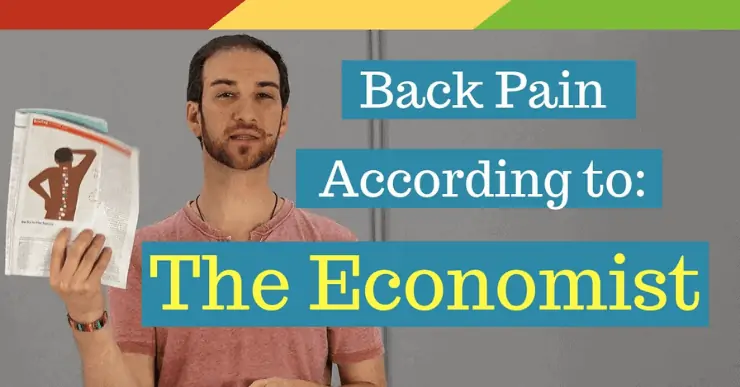
In this video, Leon discusses the 5 key takeaways from the Economist briefing on chronic back pain. Many of these points are aligned with the evidence we post regularly on this website.
Takeaway #1 – X-rays and other imaging procedures are not good predictors of pain.
- About 50% of the population undergoing MRI scans find some degree of spinal abnormality on imaging.
- These abnormalities may include bulging discs, herniated discs, spinal wear and tear, etc.
- These findings don’t always correlate with the pain a patient is experiencing – some patients have significant spinal issues but experience no symptoms.
- Results of imaging don’t always help determine the underlying cause of back pain.
- Sometimes imaging will find a spinal issue but that doesn’t always mean that issue is the source of pain.
- Further diagnostic workup is often needed to determine the cause of back pain.
- Disc degeneration is seen on imaging in about ½ of young to middle-aged adults with back pain, and in about 1/3 of patients with no back pain at all.
- Disc protrusion is seen on imaging in about 40% of patients with back pain, but also in approximately 20% of those who are pain-free.
- There is a broad consensus from the University of Southern Denmark that about 80% of such scans are useless.
Takeaway #2 – Prescription medications (like opioids) don’t necessarily help with back pain.
- Many doctors continue to prescribe medications for pain control, including opioids.
- Research is finding that these medications don’t necessarily help control back pain, but have other side effects, including:
- Making you feel loopy.
- Decreasing quality of life.
- These medications may also lead to addiction.
Takeaway #3 – Back surgery doesn’t actually help many back pain patients.
- Many patients have surgery but continue to experience significant pain several years later.
- For example – spinal fusion surgery is often used for degeneration of spinal discs. In 2015 approximately 85,000 of these procedures were performed. However, 2 years after treatment 87% of patients still had severe back pain requiring medication, and 15% had additional surgery
- Surgery should be a last resort after exhausting all conservative treatment options.
- Surgeons do not always follow the evidence.
- Be informed before undergoing back surgery – get a second, and maybe even a third, opinion.
Takeaway #4 – New research is coming out surrounding pain science.
- Research is showing that chronic pain can be coming from your brain as the brain interrupts the pain you’re feeling.
- A lot of people don’t want to hear this, or are uninformed about the connection between mental health and chronic pain.
- Stress at work, or in personal relationships, etc. may be contributing to your chronic pain.
- There’s a lot more to chronic pain than just the physical cause or what you may see on an X-ray.
Takeaway #5 – Exercise and stress reduction is proving to be effective for back pain.
- Daily exercise, including stretching, can help to control chronic back pain.
- Reducing stress with activities like meditation, yoga, Thai chi, and acupuncture can help to control chronic back pain.
- It’s important to not focus all of your attention on your pain.
In closing, stay active, avoid medications and surgery whenever possible, and try to treat yourself holistically.
Related:
Lower Back Pain From Sitting
5 Desk Stretches
Lower Back Pain From Running
Yoga for back pain?
Corrective Exercise Specialist (NASM-CES), Certified Personal Trainer (NASM-CPT), Professional Dancer
As a long time back sufferer Leon found unique methods to alleviate his pain using natural methods including self massage, exercise/stretching and postural habits. He founded Backintelligence.com to empower others to fix their postures and ease their back pain from home.
